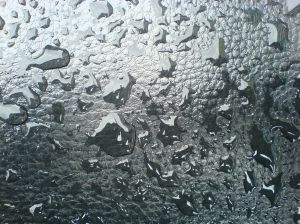News
WHY NANO LEATHER PROTECTORS ARE BAD FOR LEATHER

Nano protectors contain silicon dioxide which is a film that forms a barrier on the leather, the silicon dioxide prevents any other product penetrating the leather to keep the leather soft and the surface supple, not only that, if the leather needs any colour restoration for worn areas, scratches and worn edges this silicon dioxide prevents the leather pigment adhering to the surface, the colour will literally peel off the surface. Standard or solvent cleaners can't remove the silicon dioxide either, it will cause you more problems than it will solve.
Our leather protector remains flexible and breathable yet waterproofs the leather at the same time, our leather cleaners can also remove the protector using a standard deep clean so that colour restoration and repairs can be carried out without any issues.
HOW TO ACHIEVE A COLOUR MATCH FOR YOUR LEATHER
Achieving a Colour Match using Leather Paint
When it comes to restoring colour is everything. Whether you’re refreshing a faded sofa or a worn car seat, achieving the right colour match determines whether the finish looks professional, a poor colour match can look obvious, patchy and highlight damage. The good news? With the right approach, tools, and patience, you can master the art of colour matching using our leather paint.
Why Colour Matching Matters
Leather is a natural material, and even factory-finished products carry subtle variations in shade, undertones, and sheen. A mismatched repair stands out instantly, undermining the restoration. A precise match, on the other hand, blends seamlessly, making the leather look as if it has never been touched.
Step 1: Identify the Base Colour
Begin by observing the leather in good natural light. What’s the dominant colour—black, tan, burgundy, or something in-between? Avoid relying on artificial lighting, which can distort colour tones. Compare the leather against our standard colour range of leather paints and choose the nearest colour, this will give you a good colour base a starting point.
Step 2: Consider Undertones
Not all browns, blacks, or reds are the same. A brown leather chair might lean to orange undertones, while another brown could lean more towards a red undertone. Identifying these undertones helps you avoid mixing a colour that looks “close” but dries looking noticeably wrong.
Step 3: Mix Gradually
Our leather paints are highly pigmented, so small adjustments go a long way. Always mix in tiny increments, remember you can add more colour in to the mix but you can’t take it, trying to counter balance a colour once you’ve added too much can be quite tricky.:
- To darken most colours, brown for a warm tone, add black for a cooler tone, drop by drop.
- To lighten, use white or a lighter version of the colour you’re working on —remember, adding too much white can dull vibrancy and create a pastel tone.
- To adjust warmth, add a touch of caramel, red, or M125 tanb
- To cool down a shade, add hints of dark brown, black or grey.
Pro tip: Always test your mix on the surface and dry it immediately as the dry colour looks very different to a wet colour, remove immediately if it’s not a good match. Leather can absorb and reflect colour differently depending on the texture and sheen of the leather. Apply a layer the same thickness of consistency you will be applying during the restoration, 2-3 layers of colour will look darker than 1 layer of colour.
Step 4: Finish with Sealant
The sheen of the sealant will make the colour appear very different, a gloss sheen will look darker than a matt sheen, sometimes all that is required to tweak a colour match is actually down to the sheen rather than the colour itself. Sealing the leather also locks in the paint for added durability against wear and tear.
Common Mistakes to Avoid
- Skipping prep: Always clean the leather before restoring as you don’t want to match a colour to a dirty surface.
- Ignoring lighting: A colour that looks perfect indoors may look off in daylight—always check under multiple lighting conditions.
Final Thoughts
Colour matching with leather pigment is equal parts science and experience. It requires an eye for detail, a steady hand, and the patience to test and adjust. The reward? A flawless restoration or customisation that blends seamlessly, giving leather a second life while maintaining its timeless appeal.
WHY SADDLE SOAP IS BAD FOR UPHOLSTERY LEATHER
Saddle soap is called just that for a reason, it's intended for saddles.
It contains ingredients such as lanolin, and high levels of preservatives such as beeswax, these leave a residue which can actually attract dirt on upholstery leather.
Saddle soap is more suited for Veg Tanned leather which traditional saddles are made from, this type of leather is cut much thicker and treated differently at the tannery, it has a very natural surfaces which is absorbent so it can absorb in the lanolin and beeswax.
The majority of upholstery leather is chrome tanned and pigmented, the pigmented surface provides a solid coloured barrier, it isn't absorbent. When saddle soap is applied it sticks to the surface and can create a sticky residue, this residue then attracts dirt, eventually leading to deterioration of the leather.
